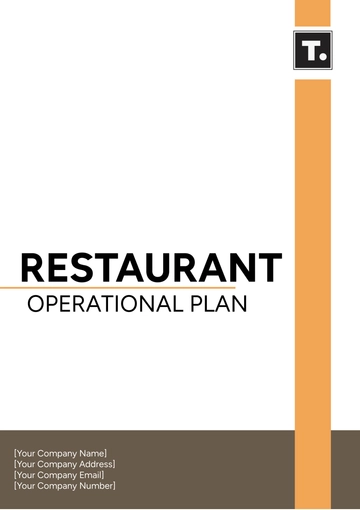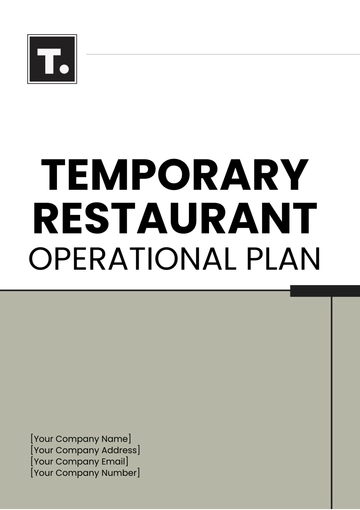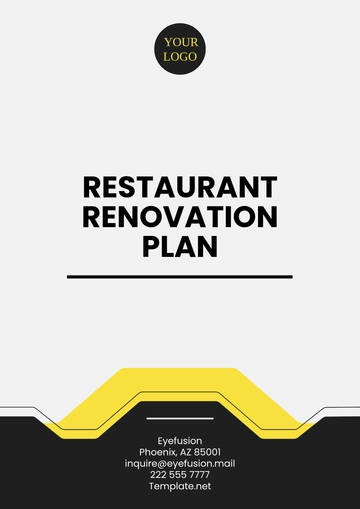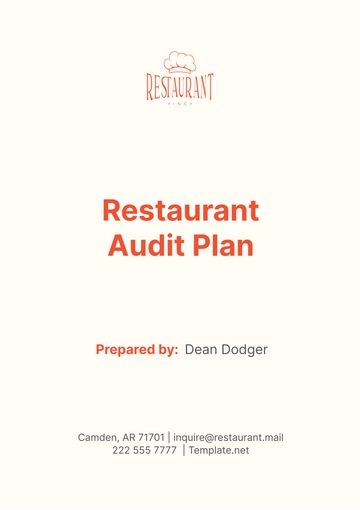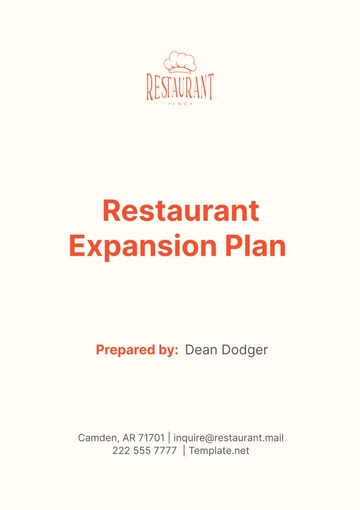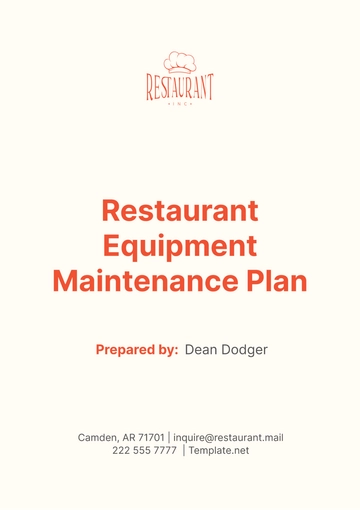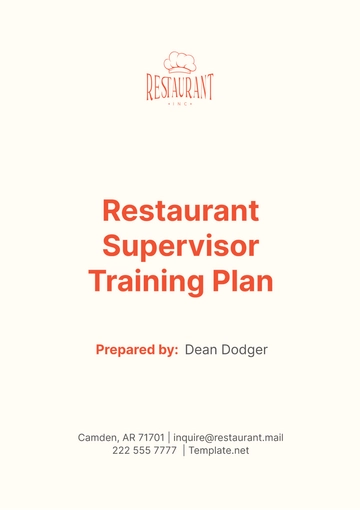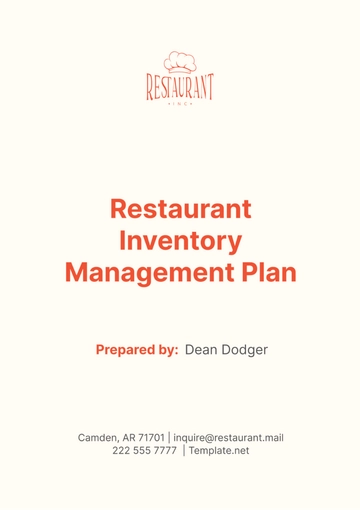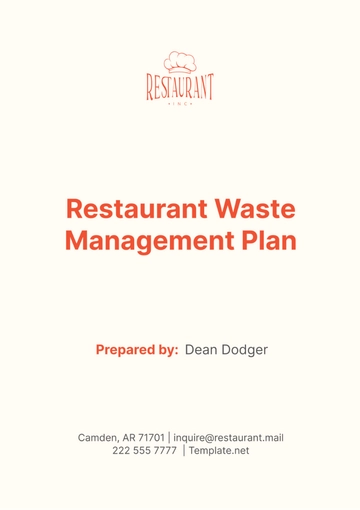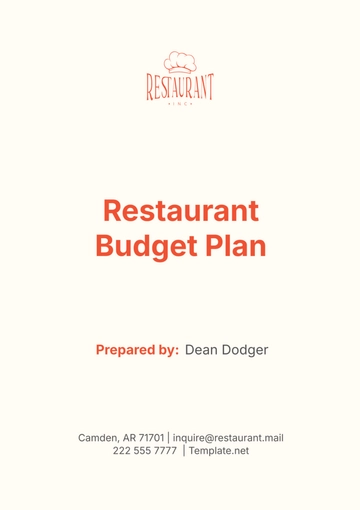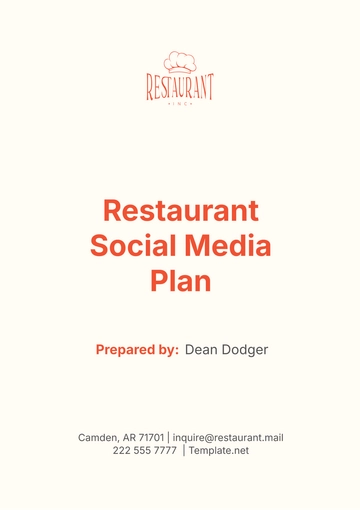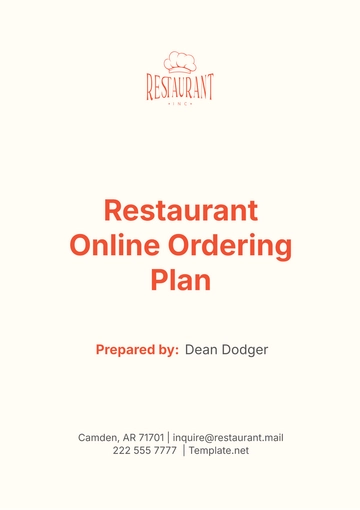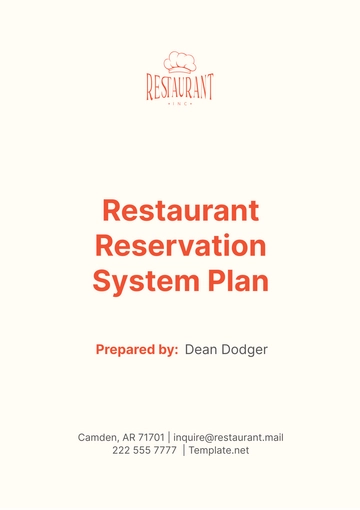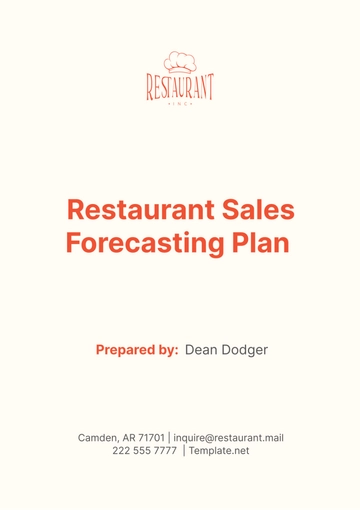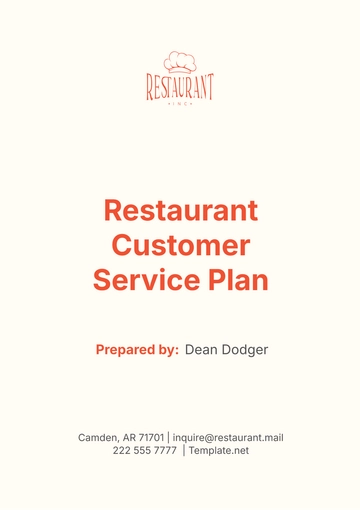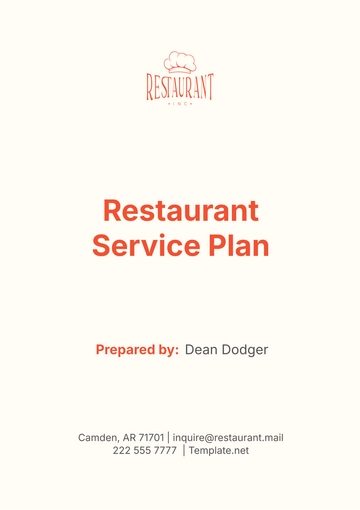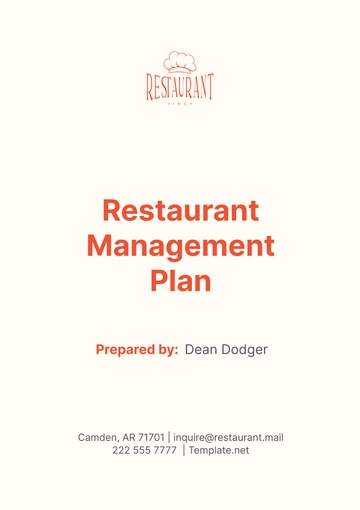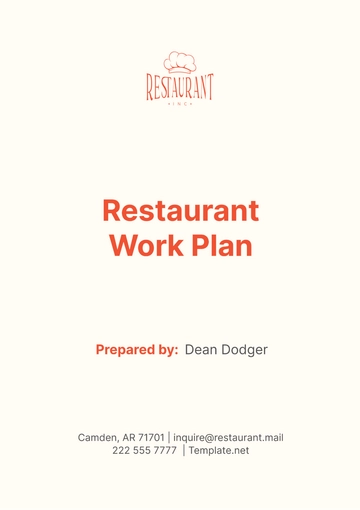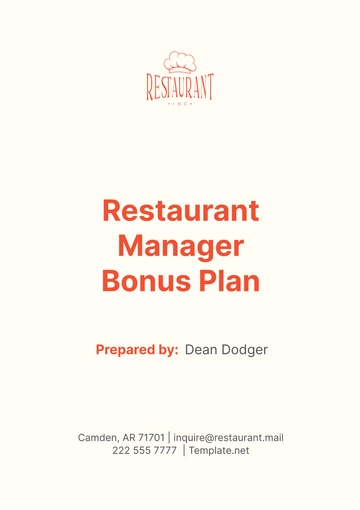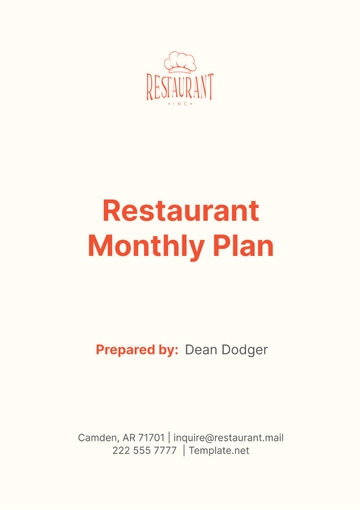Free Restaurant Sales Forecasting Plan
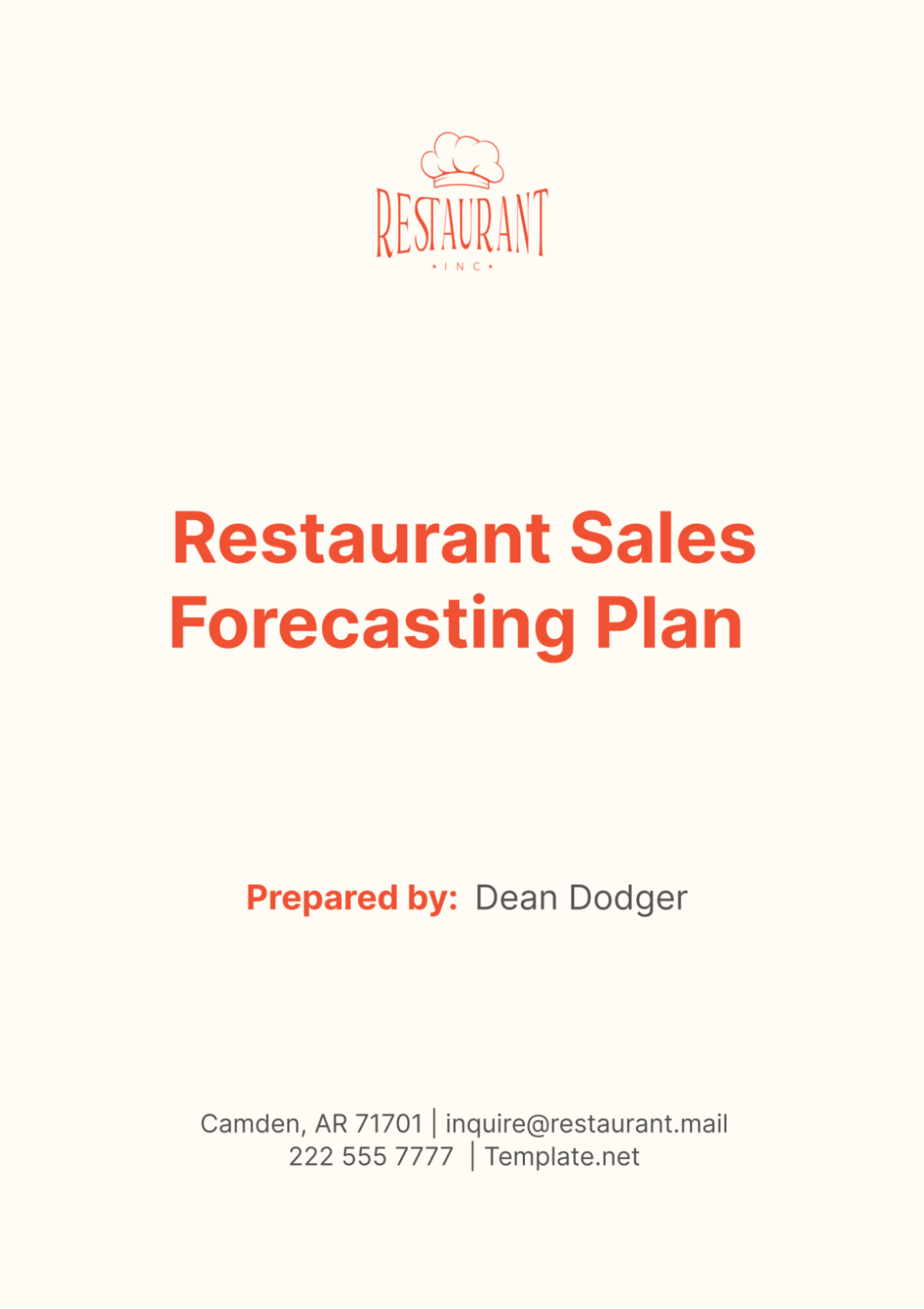
I. Executive Summary
The Restaurant Sales Forecasting Plan for [Your Company Name] aims to establish a robust framework for predicting future sales, which is crucial for effective operational and financial planning. The primary objective of this plan is to provide an accurate sales forecast that will guide decision-making processes related to inventory management, staffing, budgeting, and marketing strategies. Accurate sales forecasting enables the restaurant to optimize resource allocation, minimize waste, and enhance profitability. This plan outlines the methodologies and steps [Your Company Name] will undertake to achieve these goals, emphasizing the importance of continuous monitoring and updating of the forecast to adapt to changing market conditions.
II. Market Analysis
A. Overview of the Restaurant Industry
The restaurant industry is a dynamic and competitive sector characterized by rapid changes in consumer preferences and market trends. As of [Year], the industry is experiencing growth driven by several key factors, including an increased focus on dining experiences, the rise of food delivery services, and a growing demand for healthier and sustainable food options. According to the National Restaurant Association, the industry is expected to reach $1 trillion in sales by the end of the year, reflecting a steady annual growth rate.
B. Key Market Trends Impacting Sales
Health and Wellness: There is a significant shift towards healthier eating habits. Consumers are increasingly seeking organic, gluten-free, and plant-based options. [Your Company Name] should consider expanding its menu to include these items.
Technology Integration: The adoption of technology, such as online ordering systems, contactless payments, and AI-driven customer service, is becoming standard in the industry. Investing in these technologies can enhance customer experience and increase sales.
Sustainability: Environmental consciousness is on the rise. Customers prefer restaurants that practice sustainability, such as reducing food waste and using eco-friendly packaging.
A. Competitive Analysis
A thorough analysis of our competitors reveals the following insights:
Table 1: Competitive Analysis
Competitor | Strengths | Weaknesses |
|---|---|---|
Competitor A | Strong brand presence, extensive menu | High prices, inconsistent service quality |
Competitor B | Fast service, efficient delivery system | Limited menu options, lacks ambiance |
Competitor C | Focus on sustainability, unique menu items | Higher operational costs, niche market |
Understanding the strengths and weaknesses of our competitors helps [Your Company Name] position itself more effectively in the market. We can leverage our unique selling points (USPs) and address any gaps that competitors may have.
B. Target Market Identification
Our target market consists of urban professionals, families, and health-conscious individuals aged between 25 and 45. These customers prioritize convenience, quality, and a pleasant dining experience. By tailoring our offerings to meet the preferences and needs of this demographic, [Your Company Name] can enhance customer satisfaction and loyalty.
Demographics and Psychographics:
Age: 25-45 years
Income Level: Middle to upper-middle class
Lifestyle: Busy professionals, health-conscious, tech-savvy
Preferences: Quality food, convenience, healthy options, sustainable practices
Understanding these characteristics helps in designing marketing strategies and menu offerings that resonate with our target audience.
III. Historical Sales Data Review
A. Collection of Past Sales Data
To create a reliable sales forecast, we must first analyze our historical sales data. This involves gathering monthly and yearly sales figures from our POS systems and accounting records.
Table 2: Historical Sales Data
Year | Total Sales ($) | Growth Rate (%) | Peak Months | Off-Peak Months |
|---|---|---|---|---|
Year 1 | 1,200,000 | - | May, December | January, February |
Year 2 | 1,320,000 | 10 | June, December | February, March |
Year 3 | 1,450,000 | 9.8 | July, December | January, February |
Analyzing these figures helps identify trends and patterns, such as peak and off-peak periods. For instance, December consistently shows high sales, likely due to holiday dining.
B. Analysis of Historical Sales Trends
By examining historical sales data, we can identify several key trends:
Seasonal Sales Patterns: Sales tend to peak during the summer months and in December, likely due to increased dining out during holidays and vacations.
Impact of Promotions: Periods with targeted marketing campaigns and promotions show noticeable spikes in sales. For example, a promotional campaign in June [Year] led to a 15% increase in sales compared to the previous month.
External Events: Sales are also influenced by external events such as local festivals, economic conditions, and weather patterns. For example, unusually warm weather in May [Year] led to higher sales in outdoor dining.
C. Identifying Factors Affecting Past Sales
Understanding the factors that influenced past sales is crucial for accurate forecasting. These factors include:
Internal Factors:
Menu Changes: Introducing new dishes or special menus can drive sales. For instance, the launch of a seasonal menu in April [Year] increased sales by 12%.
Staff Performance: High staff turnover and training issues can negatively impact customer service and sales.
External Factors:
Economic Conditions: Economic downturns or booms can affect consumer spending. The economic recovery in [Year] contributed to a rise in discretionary spending on dining out.
Local Events: Sales tend to increase during local festivals and events, such as the annual food festival in June.
IV. Sales Forecasting Methods
A. Overview of Different Forecasting Methods
Sales forecasting methods can be broadly categorized into qualitative and quantitative techniques. Each method has its advantages and limitations.
Qualitative Methods:
Expert Judgment: Involves consulting with industry experts and managers who have deep insights into market trends and customer behavior.
Market Research: Includes surveys, focus groups, and customer feedback to gauge future demand.
Quantitative Methods:
Time Series Analysis: Uses historical sales data to identify patterns and project future sales. Techniques include moving averages and exponential smoothing.
Regression Analysis: Examines the relationship between sales and various independent variables, such as advertising spend and economic indicators.
B. Selection of Appropriate Forecasting Methods
For [Your Company Name], a combination of qualitative and quantitative methods will provide the most accurate forecast.
Time Series Analysis: Given our extensive historical sales data, time series analysis will help identify trends and seasonal patterns.
Market Research: Conducting surveys and focus groups will provide insights into customer preferences and potential changes in demand.
Expert Judgment: Consulting with our management team and industry experts will add a layer of qualitative insights, especially in interpreting market trends and external factors.
C. Combination of Methods for Improved Accuracy
Combining these methods allows us to cross-validate our forecasts and enhance their reliability. For instance, the results from time series analysis can be adjusted based on insights from market research and expert judgment to account for anticipated changes in customer behavior or market conditions.
V. Data Collection and Analysis
A. Gathering Relevant Data for Forecasting
Effective sales forecasting requires comprehensive and accurate data. [Your Company Name] will gather data from multiple sources to ensure a robust forecast.
Sources of Data:
Sales Data from POS Systems: Daily, weekly, and monthly sales figures.
Customer Feedback and Surveys: Information on customer satisfaction, preferences, and suggestions.
Industry Reports and Market Research: Data on market trends, economic indicators, and competitive analysis.
B. Data Analysis Techniques
Once data is collected, various analysis techniques will be employed to derive meaningful insights and trends.
Statistical Analysis:
Descriptive Statistics: Summarizing data using measures such as mean, median, and standard deviation.
Trend Analysis: Identifying underlying trends in sales data over time.
Forecasting Software and Tools:
Utilizing forecasting software like IBM SPSS, SAS, or Tableau to perform advanced statistical analysis and create visualizations that help in understanding trends and patterns.
Example of Data Analysis
Table 3: Monthly Sales Data Analysis
Month | Sales ($) | Seasonal Index | Adjusted Sales ($) |
|---|---|---|---|
January | 100,000 | 0.85 | 117,647 |
February | 110,000 | 0.88 | 125,000 |
March | 115,000 | 0.90 | 127,778 |
April | 120,000 | 1.00 | 120,000 |
May | 130,000 | 1.10 | 118,182 |
June | 135,000 | 1.15 | 117,391 |
July | 140,000 | 1.20 | 116,667 |
August | 130,000 | 1.10 | 118,182 |
September | 125,000 | 1.05 | 119,048 |
October | 115,000 | 1.00 | 115,000 |
November | 110,000 | 0.95 | 115,789 |
December | 140,000 | 1.20 | 116,667 |
The seasonal index helps adjust sales figures to account for seasonal variations, providing a clearer picture of underlying trends.
VI. Developing the Sales Forecast
A. Creating a Baseline Forecast
Developing a sales forecast for [Your Company Name] begins with creating a baseline forecast using historical sales data and identified trends. This forecast provides a foundation on which further adjustments and refinements can be made based on various internal and external factors.
Table 4: Baseline Monthly Sales Forecast [Year]
Month | Projected Sales ($) |
|---|---|
January | 105,000 |
February | 115,000 |
March | 120,000 |
April | 125,000 |
May | 135,000 |
June | 140,000 |
July | 145,000 |
August | 135,000 |
September | 130,000 |
October | 120,000 |
November | 115,000 |
December | 150,000 |
The baseline forecast is derived by analyzing past sales trends, adjusting for seasonality, and using moving averages to smooth out short-term fluctuations.
B. Adjusting the Forecast for Influencing Factors
After establishing the baseline, we adjust the forecast for factors that can influence sales, including marketing and promotional plans, economic indicators, local events, and changes in menu or pricing.
Marketing and Promotional Plans: Promotional activities, such as discounts, special events, and marketing campaigns, have a direct impact on sales. For instance, a planned summer promotional campaign is expected to boost sales by 10% in June and July.
Economic Indicators: Economic conditions affect consumer spending. We will consider economic forecasts indicating a moderate economic growth of 2% for [Year], which suggests a slight increase in discretionary spending on dining out.
Local Events: Local events such as festivals, sports events, and community gatherings can significantly increase foot traffic. We will identify key events in our locality and adjust sales projections accordingly. For example, an annual food festival in June is expected to increase sales by 15%.
Changes in Menu or Pricing: Introducing new menu items or adjusting prices can influence sales. A planned menu expansion in April is projected to increase monthly sales by 5%.
Table 5: Adjusted Monthly Sales Forecast (2024)
Month | Baseline Sales ($) | Promotional (%) | Economic (%) | Event (%) | Menu (%) | Final Adjusted Sales ($) |
|---|---|---|---|---|---|---|
January | 105,000 | 0 | 2 | 0 | 0 | 107,100 |
February | 115,000 | 0 | 2 | 0 | 0 | 117,300 |
March | 120,000 | 0 | 2 | 0 | 0 | 122,400 |
April | 125,000 | 0 | 2 | 0 | 5 | 133,875 |
May | 135,000 | 0 | 2 | 0 | 0 | 137,700 |
June | 140,000 | 10 | 2 | 15 | 0 | 178,360 |
July | 145,000 | 10 | 2 | 0 | 0 | 162,050 |
August | 135,000 | 0 | 2 | 0 | 0 | 137,700 |
September | 130,000 | 0 | 2 | 0 | 0 | 132,600 |
October | 120,000 | 0 | 2 | 0 | 0 | 122,400 |
November | 115,000 | 0 | 2 | 0 | 0 | 117,300 |
December | 150,000 | 0 | 2 | 0 | 0 | 153,000 |
C. Scenario Planning and Sensitivity Analysis
Scenario planning and sensitivity analysis are essential for understanding the potential range of outcomes and the impact of different variables on sales.
Best-Case Scenario:
Assumes higher-than-expected economic growth (3%) and successful promotional campaigns.
Result: Potential sales increase by an additional 5%.
Worst-Case Scenario:
Assumes economic downturn (negative growth) and lower effectiveness of promotional activities.
Result: Potential sales decreased by 10%.
Most-Likely Scenario:
Based on moderate economic growth and average promotional effectiveness, as reflected in the final adjusted forecast above.
VII. Monitoring and Updating the Forecast
A. Establishing a Monitoring System
Continuous monitoring is crucial to ensure the sales forecast remains accurate and relevant. [Your Company Name] will establish a robust monitoring system to track actual sales against the forecast.
Key Components:
Monthly Sales Reports: Detailed reports generated from POS systems to track sales performance.
Variance Analysis: Identifying and analyzing variances between actual sales and forecasted sales.
Performance Metrics: Key performance indicators (KPIs) such as average transaction value, customer footfall, and sales per employee.
Table 6: Sales Monitoring Dashboard
Month | Forecasted Sales ($) | Actual Sales ($) | Variance ($) | Variance (%) |
|---|---|---|---|---|
January | 107,100 | 105,000 | -2,100 | -1.96 |
February | 117,300 | 120,000 | 2,700 | 2.30 |
March | 122,400 | 121,000 | -1,400 | -1.14 |
April | 133,875 | 135,000 | 1,125 | 0.84 |
B. Updating the Forecast as Needed
Regular updates to the sales forecast are essential to reflect new information and changing conditions. [Your Company Name] will review and update the forecast quarterly or as significant events occur.
Steps for Updating the Forecast:
Review Actual Sales: Analyze actual sales data and compare it with the forecast.
Identify Variances: Determine the reasons for variances, such as changes in customer behavior, economic shifts, or unplanned events.
Adjust Assumptions: Update assumptions based on new insights and external factors.
Revise Forecast: Adjust the forecast to incorporate the updated assumptions and data.
By following this process, we ensure that our sales forecast remains a reliable tool for strategic planning.
VIII. Action Plan and Implementation
A. Defining Actions Based on the Sales Forecast
The sales forecast provides actionable insights that guide various aspects of restaurant operations, including resource allocation, marketing strategies, and inventory management.
Resource Allocation:
Staffing: Adjusting staffing levels based on projected peak and off-peak periods to optimize labor costs and maintain service quality.
Inventory Management: Ordering appropriate inventory levels to meet forecasted demand, reducing waste and ensuring fresh supplies.
Marketing and Promotional Strategies:
Targeted Campaigns: Planning marketing campaigns around forecasted peak periods to maximize their impact.
Loyalty Programs: Implementing loyalty programs to retain customers and encourage repeat visits.
Operational Adjustments:
Menu Planning: Introducing seasonal menu items based on customer preferences and forecasted demand.
Customer Service Training: Ensuring staff are trained to handle expected customer volume and provide excellent service.
Table 7: Action Plan Based on Sales Forecast
Action Item | Responsible Team | Timeline | Expected Outcome |
|---|---|---|---|
Adjust Staffing Levels | Operations Manager | Monthly | Optimized labor costs, improved service |
Inventory Management | Supply Chain Manager | Bi-Weekly | Reduced waste, ensured fresh supplies |
Marketing Campaigns | Marketing Team | Quarterly | Increased sales, higher customer engagement |
Menu Planning | Executive Chef | Seasonal | Enhanced customer satisfaction, higher sales |
Customer Service Training | HR Department | Ongoing | Improved customer experience |
B. Implementing the Sales Forecast in Operations
Implementing the sales forecast involves effective communication with staff and stakeholders, as well as providing the necessary training and support to ensure successful execution.
Communication:
Staff Meetings: Regular meetings with staff to discuss the sales forecast, explain its importance, and outline their roles in achieving the forecasted targets.
Stakeholder Updates: Informing stakeholders, including suppliers and investors, about the forecast and its implications for the business.
Training and Support:
Staff Training: Providing training sessions to ensure staff understand how to manage increased customer volume and deliver excellent service.
Support Tools: Implementing tools such as forecasting software, inventory management systems, and customer feedback platforms to support the forecast.
By integrating the sales forecast into daily operations, [Your Company Name] ensures that all team members are aligned and working towards common goals.
IX. Conclusion
The sales forecasting plan for [Your Company Name] is a comprehensive approach designed to predict future sales accurately and guide strategic decisions. By analyzing market trends, historical sales data, and various influencing factors, we create a reliable baseline forecast. Adjustments based on marketing plans, economic indicators, and local events further refine the forecast, while scenario planning helps prepare for different potential outcomes.
Continuous monitoring and updating of the forecast ensure it remains relevant and accurate, providing actionable insights for resource allocation, marketing strategies, and operational adjustments. Implementing the forecast involves effective communication, staff training, and the use of support tools to achieve forecasted targets.
Thus, an accurate sales forecast is essential for the success of [Your Company Name], enabling us to optimize operations, enhance customer satisfaction, and drive profitability. By following this detailed plan, we are well-equipped to navigate the dynamic restaurant industry and achieve sustained growth.
- 100% Customizable, free editor
- Access 1 Million+ Templates, photo’s & graphics
- Download or share as a template
- Click and replace photos, graphics, text, backgrounds
- Resize, crop, AI write & more
- Access advanced editor
Predict your sales accurately with Template.net's Restaurant Sales Forecasting Plan Template. This customizable and editable template, accessible through the Ai Editor Tool, helps you create reliable sales projections. Personalize it to reflect your restaurant’s unique business model and trends. Develop a professional plan to guide your financial planning and ensure your restaurant’s profitability and growth.
You may also like
- Finance Plan
- Construction Plan
- Sales Plan
- Development Plan
- Career Plan
- Budget Plan
- HR Plan
- Education Plan
- Transition Plan
- Work Plan
- Training Plan
- Communication Plan
- Operation Plan
- Health And Safety Plan
- Strategy Plan
- Professional Development Plan
- Advertising Plan
- Risk Management Plan
- Restaurant Plan
- School Plan
- Nursing Home Patient Care Plan
- Nursing Care Plan
- Plan Event
- Startup Plan
- Social Media Plan
- Staffing Plan
- Annual Plan
- Content Plan
- Payment Plan
- Implementation Plan
- Hotel Plan
- Workout Plan
- Accounting Plan
- Campaign Plan
- Essay Plan
- 30 60 90 Day Plan
- Research Plan
- Recruitment Plan
- 90 Day Plan
- Quarterly Plan
- Emergency Plan
- 5 Year Plan
- Gym Plan
- Personal Plan
- IT and Software Plan
- Treatment Plan
- Real Estate Plan
- Law Firm Plan
- Healthcare Plan
- Improvement Plan
- Media Plan
- 5 Year Business Plan
- Learning Plan
- Marketing Campaign Plan
- Travel Agency Plan
- Cleaning Services Plan
- Interior Design Plan
- Performance Plan
- PR Plan
- Birth Plan
- Life Plan
- SEO Plan
- Disaster Recovery Plan
- Continuity Plan
- Launch Plan
- Legal Plan
- Behavior Plan
- Performance Improvement Plan
- Salon Plan
- Security Plan
- Security Management Plan
- Employee Development Plan
- Quality Plan
- Service Improvement Plan
- Growth Plan
- Incident Response Plan
- Basketball Plan
- Emergency Action Plan
- Product Launch Plan
- Spa Plan
- Employee Training Plan
- Data Analysis Plan
- Employee Action Plan
- Territory Plan
- Audit Plan
- Classroom Plan
- Activity Plan
- Parenting Plan
- Care Plan
- Project Execution Plan
- Exercise Plan
- Internship Plan
- Software Development Plan
- Continuous Improvement Plan
- Leave Plan
- 90 Day Sales Plan
- Advertising Agency Plan
- Employee Transition Plan
- Smart Action Plan
- Workplace Safety Plan
- Behavior Change Plan
- Contingency Plan
- Continuity of Operations Plan
- Health Plan
- Quality Control Plan
- Self Plan
- Sports Development Plan
- Change Management Plan
- Ecommerce Plan
- Personal Financial Plan
- Process Improvement Plan
- 30-60-90 Day Sales Plan
- Crisis Management Plan
- Engagement Plan
- Execution Plan
- Pandemic Plan
- Quality Assurance Plan
- Service Continuity Plan
- Agile Project Plan
- Fundraising Plan
- Job Transition Plan
- Asset Maintenance Plan
- Maintenance Plan
- Software Test Plan
- Staff Training and Development Plan
- 3 Year Plan
- Brand Activation Plan
- Release Plan
- Resource Plan
- Risk Mitigation Plan
- Teacher Plan
- 30 60 90 Day Plan for New Manager
- Food Safety Plan
- Food Truck Plan
- Hiring Plan
- Quality Management Plan
- Wellness Plan
- Behavior Intervention Plan
- Bonus Plan
- Investment Plan
- Maternity Leave Plan
- Pandemic Response Plan
- Succession Planning
- Coaching Plan
- Configuration Management Plan
- Remote Work Plan
- Self Care Plan
- Teaching Plan
- 100-Day Plan
- HACCP Plan
- Student Plan
- Sustainability Plan
- 30 60 90 Day Plan for Interview
- Access Plan
- Site Specific Safety Plan


